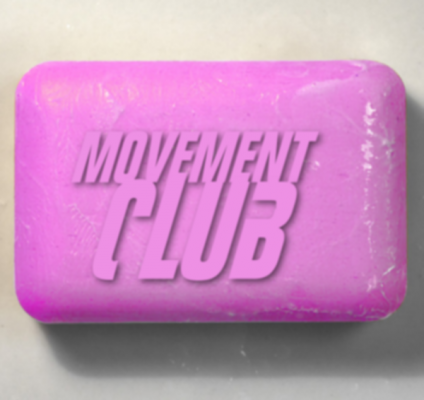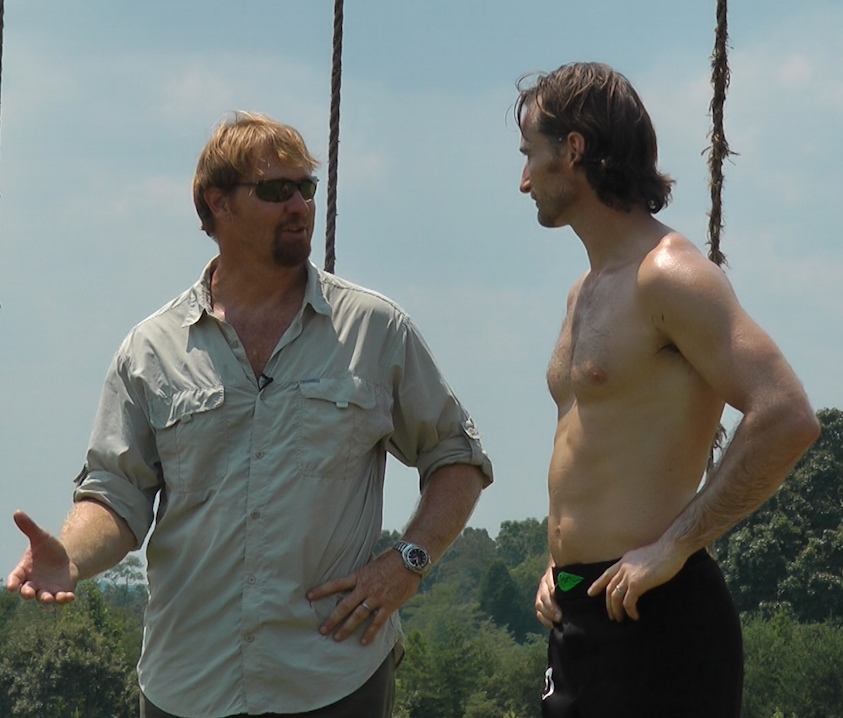Thorax: An Immovable Cage or a Mobile Spring?
Written by Brett Jones FMS
The thoracic spine and rib cage together, the thorax, perform as a central player in healthy mobility and our ability to support human movement and performance. Another exciting aspect is that it is also part of the entire spinal "engine" as described by Gracovetsky. One of the best descriptions I have found for thoracic function comes from a September 2007 Newsletter by Robert Burgess, BEd, PT, PhD, Feldenkrais Practitioner, where he began the conversation with: "An immovable cage or a mobile spring?
Think about it - with all of those ribs connecting to the spine and up front on the sternum how can there be much movement in the rib cage?”
Well, let us examine this further...Burgess in his newsletter cites Buchalter et al 1988 and Willems et al 1996 for data on movement in the thoracic spine. The Thoracic spine provides us with 50 degrees of rotation, 26 degrees of side bending, 25 degrees of extension and 30 degrees of flexion in sitting -
"...in fact with each pair of ribs moving on the next- the thorax behaves like a hooped spring."
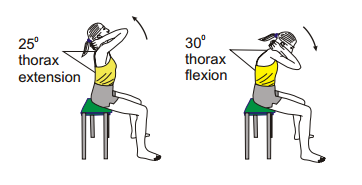
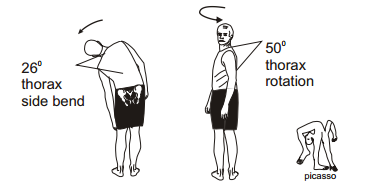
"The pelvis and thorax rotate in opposing directions and together with side bending are the prime movers of human locomotion (Gracovetsky 1997)."
Quick Anatomy Review...
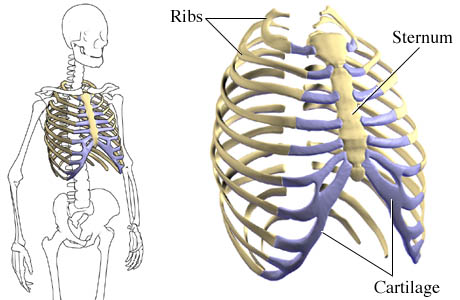
The ribs connect to the spine and sternum? Surely that means the thorax is rigid - doesn't it? Well no, not if you look at the actual anatomy of the area a little closer.
The ribs connect up front on the sternum by way of a large series of cartilage joints - rather than being more solid "bone to bone" joints like the Sternoclavicular joint. These cartilage joints provide a more mobile situation and even the sternum has at least two semi-movable joints in its structure.
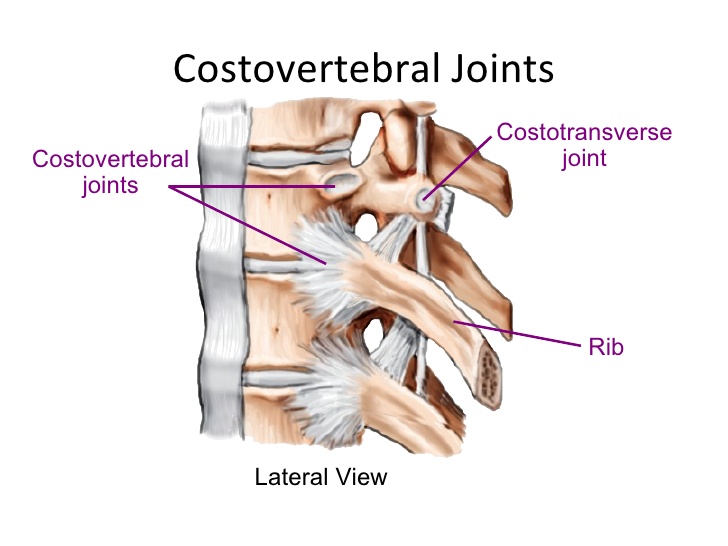
There are two joints where the ribs meet the thoracic vertebrae – the costotransverse and the costovertebral – and this creates even more “interesting” movement for the t-spine.
Also, just think about breathing and CPR - you can compress the chest 2"+ during CPR - Where does that movement come from?
So, we must ask the question again, do the t-spine and ribs form a “cage” or a “spring”?
Breathing
If we are breathing correctly and using the diaphragm and intercostals for respiration, there is a tremendous amount of movement in the thoracic spine and lower rib cage. However, most people breath through their traps and upper chest which facilitates the development of kyphosis (rounding of the upper back), tension in the anterior chain and a rigid rib cage.
So let’s talk functional movement…
Having a mobile thorax is a key component of moving well and there are some great drills to improve and restore your t-spine and rib cage movement to contribute to the great spinal engine. From an FMS perspective, we identify the need for thorax mobility during Shoulder Mobility or In-line Lunge movement patterns where the screens expose a limitation. In the SFMA, a thorax mobility limitation can be found in the multi-segmental extension(MSE), multi-segmental rotation(MSR), and Upper Extremity(UE) breakouts. This will point us in the right corrective strategy direction and help us prioritize thorax mobility. When this becomes our priority, FMS has some very effective corrective strategies that we use. Below are three thorax drills that can improve and maintain good mobility and each gives us a little different opportunity to make improvement based on an individual’s needs. Let’s take a look!
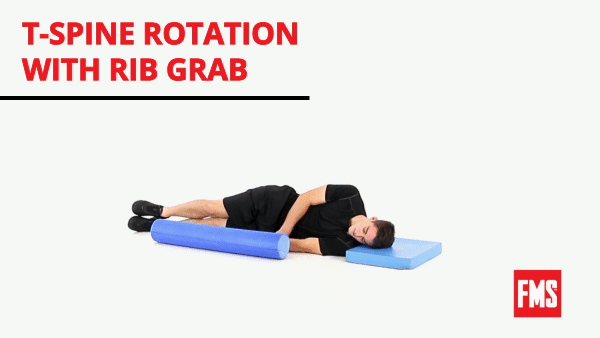 1) Rib Grab: The Rib Grab is a great breath assisted thorax opening drill using deep diaphragmatic breathing to improve mobility. It is performed in a spine supported positions that creates minimal stability demands and lets the individual focus on the natural rotation and syncing the breath. Done with care and attention to the set-up it can lock out the lumbar and provide a great left to right appraisal of thorax rotation.
1) Rib Grab: The Rib Grab is a great breath assisted thorax opening drill using deep diaphragmatic breathing to improve mobility. It is performed in a spine supported positions that creates minimal stability demands and lets the individual focus on the natural rotation and syncing the breath. Done with care and attention to the set-up it can lock out the lumbar and provide a great left to right appraisal of thorax rotation.
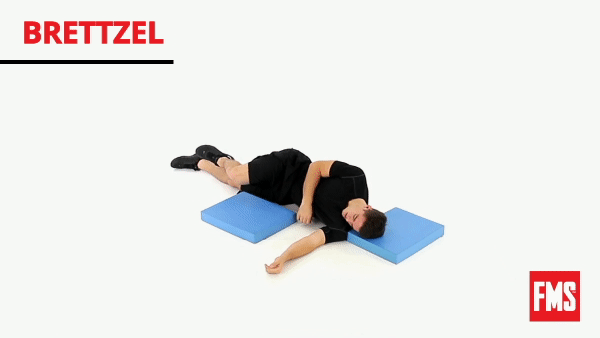
2) Brettzel: The Brettzel incorporates a challenge to the anterior chain of the opposite side hip. (Shoulders rotate right with the left hip anterior chain challenged hip extension and knee flexion) So you can see if your thorax mobility is being influenced by a tight anterior chain/hip. This is also a drill relying on good diaphragmatic breathing and we want to see the same thorax mobility here as in the Rib Grab.
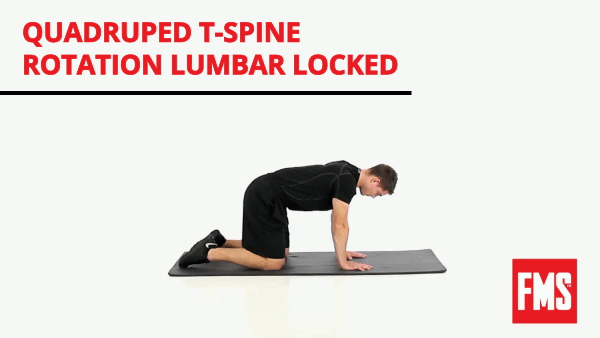 3) Lumbar Lock T-spine Rotation: The Lumbar Lock T-spine Rotation transitions into an active mobility drill by bringing you up into a spine suspended position that engages more stability demands. Making sure the active mobility matches the previous breath assisted mobility is a good progressive way to use the corrective strategies in working on the thorax.
3) Lumbar Lock T-spine Rotation: The Lumbar Lock T-spine Rotation transitions into an active mobility drill by bringing you up into a spine suspended position that engages more stability demands. Making sure the active mobility matches the previous breath assisted mobility is a good progressive way to use the corrective strategies in working on the thorax.
Important note: you should not feel any of these in the lumbar spine (lower back).
Wrapping it up…
Whether an FMS professional improving Shoulder Mobility or an SFMA professional improving MSE, MSR, or UE, the thorax can be a critical area to address. The human body thrives when breathing, thorax mobility and shoulder mobility will provide better movement feedback throughout the neuromuscular system and let your clients use the “spinal engine” for better movement and performance regardless of their activity or performance goals.
For more information, check out the FMS 2 Online Course- Corrective Strategies or the upcoming FMS 2 Virtual Live Course.
Author
 Brett Jones, StrongFirst Director of Education, is a Certified Athletic Trainer and Strength and Conditioning Specialist based in Pittsburgh, PA. Mr. Jones holds a Bachelor of Science in Sports Medicine from High Point University, a Master of Science in Rehabilitative Sciences from Clarion University of Pennsylvania, and is a Certified Strength & Conditioning Specialist (CSCS) from the National Strength and Conditioning Association (NSCA).
Brett Jones, StrongFirst Director of Education, is a Certified Athletic Trainer and Strength and Conditioning Specialist based in Pittsburgh, PA. Mr. Jones holds a Bachelor of Science in Sports Medicine from High Point University, a Master of Science in Rehabilitative Sciences from Clarion University of Pennsylvania, and is a Certified Strength & Conditioning Specialist (CSCS) from the National Strength and Conditioning Association (NSCA).
With over twenty years of experience, Brett has been sought out to consult with professional teams and athletes, as well as present throughout the United States and internationally.
As an athletic trainer who has transitioned into the fitness industry, Brett has taught kettlebell techniques and principles since 2003. He has taught for Functional Movement Systems (FMS) since 2006 and has created multiple DVDs and manuals with world-renowned physical therapist Gray Cook, including the widely-praised “Secrets of…” series.
Brett continues to evolve his approach to training and teaching and is passionate about improving the quality of education for the fitness industry.
He is available for consultations and distance coaching by e-mailing him at appliedstrength@gmail.com.
Related Resources
-
Movement Club
Posted by Gray Cook
-
Movement Principle # 1
Posted by Gray Cook
Please login to leave a comment
1 Comments
-

Bryan Ales 12/9/2019 1:45:50 PM
Great information, had a more rigid view of the T-spine prior to this. Although I will point out that typically the 2"+ depth of compression during CPR typically results in broken ribs, the cage may be mobile but it still has bars that aren't.




